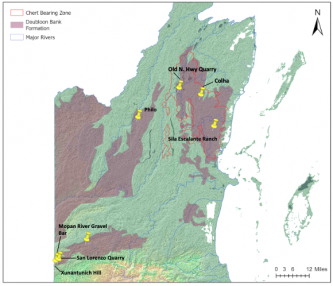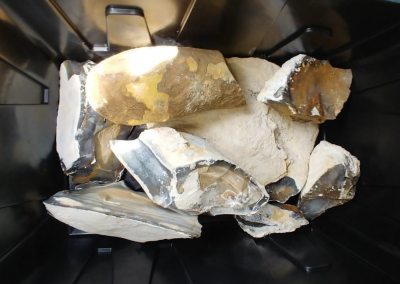Proposal
Research Objective
The chemical characterisation of chert tools found in the archaeological record of prehistoric sites is essential for determining their provenance and thus, inferring mobility and lithic procurement strategies. Chert resources are abundant in archaeological contexts and were usually preferred to other raw materials due to their physical and mechanical properties in relation to knapping tools. While the characterisation of chert has traditionally used textual and visual features, the results are often too dependent on the identifier’s expertise rather than quantifiable and measurable attributes thus driving the need for new methods in chert source identification. Over the last two decades the development of geochemical methods and analyses has redefined how we characterised chert artefacts.
While successful use of chert chemical characterisation has been successfully used across a number of regions, the Maya region has largely been overlooked in respect to this research. Currently the application of trace element analysis to sources of chert from northern Belize has been minimal and provided results that could not discriminate chemically between different chert formations and sample areas. Majority of lithic sourcing studies in this region have been focused on typological or visual aspects of chert artifacts (e.g., Mitchum 1994; Hester and Shafer 1984), while a small handful have incorporated trace element analyses (Tobey 1984; Cackler 1999, 2000). Visual sourcing of chert is problematic in many ways (Luedtke 1979). Not only does this require great expertise and experience in a specific region, but the geological study of chert outcrops has demonstrated that cherts from different geological formations and different geographic areas are often visually identical. In addition, the chance of wrongly categorising artefacts is too great, and grouping artefacts based on a subjective opinion cannot be easily reproduced or quantified. In regard to previous chemical studies on Belize chert, it is clear that a greater care needs to be taken in developing a geochemical database. The need for consideration of variability within chert formations and a larger sample size were overlooked in the methodological development (Tobey 1984; Crackler 1999, 2000). However, both studies showed several instances of microvariation within the dataset.
The proposed method will incorporate the use of LA-ICP-MS to determine the trace elemental composition of chert samples from Northern Belize. These samples have been collected from a number of locations across the region, from both primary and secondary deposits. The proposed methodology will aim to distinguish between the chemical compositions of each sample location, or “source”. A total of 36 elements will be analysed based on the use of these elements in other chert characterisation studies. While final source discrimination within previous studies has been based on a smaller subset of analytes, for the current project it is best to start with a complete dataset as the geochemical characteristics of Belize chert that are of value are largely unknown.
Significance
The fundamental theoretical principal behind all provenance studies is the “provenance postulate”, first stipulated by Weigand et al. (1997). The postulate assumes that the difference between distinct sources of raw material may be recognised analytically, and that the compositional variability will be greater between the sources rather than within them. This theory is critical in considering a methodology that can be successfully applied to chert. Arguably, the most critical issue limiting the use of chert provenance data is precision, in other words, the ability of an applied technique to identify the right elements and their values enough so to differentiate between one source and another.
Chert is part of a group of sedimentary SiO2 rocks formed by chemical, biochemical and digenetic SiO2 precipitation, best known as “silicates”. Chert forms a central component of this groups, being a fine-grained sedimentary rock, composed predominantly of silicon dioxide (SiO2) minerals (>90%). In primarily deposition, it occurs in the form of concretionary masses, nodules, or layers (tabular chert). They break with a conchoidal fractures, often producing very sharp edges, perfect for prehistoric tool manufacture and use. Typically, chert is composed predominately of Si, but also includes other major elements (e.g., Al, Fe, Mn, Ca, Ti), trace elements (e.g., Sr, Th) and rare-earth elements (e.g., La, Ce, Nd, Sm, Eu). However, the chemical composition of chert is subject to change due to the movement of mobile elements in its matrix. Mobile elements, such as Sc, Th, Sr, Rb, Cs, Mn, Al, Ba, and U can provide diagenetic-metamorphic signatures and can show variability for outcrops within the same stratigraphic units. Immobile elements, such as Ce, La, Eu, Sm can be used as indicators of provenance and depositional environments. These elements reflect the primary source locations for which secondary sources may be derived and can be used to discriminate between cherts from different formations and units.
Due to the heterogenous nature of siliceous rocks and the typically very low trace element concentrations, ICP-MS has been increasingly used for chemical characterisation. The additional use of laser abolition has greatly increased the usefulness of ICP-MS in terms of archaeological research. ICP-MS required that solid samples be digested into solution, meaning that the sample is completely altered and spatial information present in the sample is lost, both important features to this research. The use of laser ablation completely removes these steps from the analyses, making the technique more useful for archaeological material.
LA-ICP-MS has been applied to the Edwards Plateau Chert (Texas) (Speer 2014), White River Badlands (southwest Dakota) (Hoard et al. 1991, 1993, Huckle et al. 2011), northern parts of the Apulia region (Italy) (Delluniversità et al. 2020), Gargano promontory (Italy) (Tarantinit et al. 2016), northern Bulgaria flint (Gurova et al. 2021). All cherts from these regions are found within limestone formations, that are a product of shallow and deep-water marine environments. Of relevance to the authors’ research is limestone formations bearing chert found in Northern Belize. Geologically, Belize can be divided into the Corozal Basin in the north and the Belize basin in the south, both separated by the Maya mountains. The Corozol Basin is comprised of a thick sequence of non-clastic sediments and is characterised by a predominantly marine carbonate sequence (Flores 1952). This region is comprised primarily of three geological formations; The Orange Walk group, Barton Creek formation and the El Cayo (Doubloon Bank) group. Samples collected for this project are representative of the Doubloon Bank formation. The Middle Eocene Doubloon Bank formation consists of limestone that is cream to buff, yellow to orange, dense, hard and shows a slightly marly context. In places, large, dark centred chert nodules characterised the formation. Flores (1952) notes that foraminifera (E.g., Miliolids and Globigerina) are “in general well preserved and relatively abundant” within the formation.

As mentioned above, previous studies (Tobey 1986, Crackler et al. 1999) located in Belize have failed to produce reliable sources distinctions between Corozol Basin samples. Additionally, their sampling strategy only targeted source areas within the “chert bearing zone”, a region defined by its abundance of readily available chert. As a result, a gap remains in our understanding on the specific movement of chert artefacts across the Maya lowlands.
Materials and Methods
During the summer months of 2022, geological samples from bedded and nodular chert contexts in northern Belize were obtained by researchers. These samples were collected from 7 different locations broadly within the Corozol Basin, all of these locations are associated with the Doubloon Bank Formation of El Cayo.
Two hypothesis will be tested;
(1) Elemental concentrations will differ between each individuals site, and source clusters can be establsihed from the data.
(2) There will be variation of elemental concentrations within each particular site location, but not extensive enough to prevent the creation of source clusters based on elemental data.
Total of 33 individual samples will be used in this project. Sample preparation for this project includes, cutting the samples into small “chips” (1x1x0.5cm) and imbedding them into resin mounts. Depending on the size of each sample, some maybe produce 2 or 3 “chips” that will be treated as separate samples from that locality. These resin mounts will be polished in order to avoid analysing chemically altered rock surfaces and to provide a flat surface for laser analysis.

For each sample, a minimum of 3 discrete locations will be analysed in order to characterise naturally occurring variation within each sample. These locations will be selected based on their lack of impurities, potentially caused by microfossils, or foreign mineral inclusions which would skew the results.
Silicon (Si) will be used as an internal standard and standard reference glass NIST SRM 610 and NIST SRM 612 will be routinely analysed for standardisation and drift correction (Elemental concentrations for standards). These standards have been applied to a number of similar chert studies (e.g., Brandl 2016, Sanchez dl la Torre 2017).
Expected Outcomes
The outcome of this research will have significant impacts on the development and application of trace elemental methodologies to archaeological research both within the Maya region and elsewhere. If this preliminary study can demonstrate that geological chert sources can be chemically distinguished from one another, then it sets the stage for large project development. Development of a larger geological database of all potential cherts sources in northern Belize will be based on the results of this project. Following this, incorporation of archaeological assemblages is possible. The difficultly with sourcing archaeological material is based around the task of matching artifact to source. However, if it can be proven that geological samples are chemically distinct from one another than it becomes possible to match artifacts back to their original point of procurement.
Timeframe and Budget
The proposed project will run an adequate number of samples, including the use of calibration samples, to answer the research question. As this is a preliminary study, the number of samples has been purposely selected from a much large geological sample set. The sample will be prepared over a one-month period and will be ready for analysis by November 12, 2022.
| Type | Cost | # Samples | Total cost |
| LA-ICP-MS | $73/hr | 33 (3 spots each)
Total of 99 |
35 spots/hr = $206 |
Total cost: $206